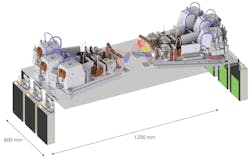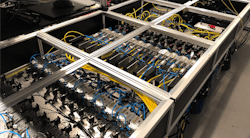High-power ultrafast lasers: The door to new applications swings open
DIETER HOFFMAN, Fraunhofer ILT
Ultrafast (that is, ultrashort-pulse) lasers offer two unique advantages: The highest precision in material processing and the ability to process almost every material. They are available with average powers of up to approximately 100 W for industrial applications. A few companies offer higher powers, but these are often systems more suited for research.
Still, the momentum for these systems is growing. Thus, 13 institutes of the German Fraunhofer Society joined their forces about 2 years ago to develop the next generation of ultrafast lasers with enough power to compete with current fiber or CO2 lasers. And because the Fraunhofer institutes are dedicated to applied research, this collaboration plans for the development of process technology and first applications as well.
This Fraunhofer Cluster of Excellence for Advanced Photon Sources is abbreviated CAPS. The Fraunhofer Society itself is a unique organization for the development and transfer of new technology. Its 72 institutes employ more than 26,000 people. Their budget of currently €2.6 billion is generated mainly from contract research. Just about a quarter is direct governmental funding.
The Fraunhofer Institutes for Laser Technology (Fraunhofer ILT; Aachen, Germany) and for Applied Optics and Precision Engineering (Fraunhofer IOF; Jena, Germany) manage the CAPS project and host the laser source development groups. They work on complementary approaches to build multikilowatt femtosecond laser systems.
The group in Aachen, which is directed by the speaker Hans Dieter Hoffmann, builds upon decade-long experience with a special slab laser design. This so-called Innoslab design was developed more than 20 years ago. First, it was designed to generate continuous-wave (CW) laser radiation efficiently with diode pumping. Soon, it became a solution for the generation of pulsed and ultrashort-pulsed laser radiation. The current version is designed for 5 kW laser radiation with 800 fs pulses from two amplifier stages (see Fig. 1). Further upscaling to 10 kW is planned and will apply a thin disk amplifier stage.
The team from Hoffmann also developed a special multipass cell for nonlinear pulse compression. It actually broadens the pulse spectrum, which can be compressed to shorter pulses afterwards. The most interesting feature of this cell is the high conversion efficiency of 96% when converting pulses down to <30 fs.
Hoffmann also reported results from his partners in Jena, where the group headed by Jens Limpert has developed the concept of coherent combination of fiber laser beams. Within this concept, almost-identical fiber amplifiers are pumped by one seed laser and they then generate amplified beams in parallel. With optimal spatial and temporal overlap, these beams can be combined with 96% combining efficiency. The current setup has reached 10.4 kW of compressed average power with 240 fs pulses (see Fig. 2).Based on the high power sources, the CAPS teams build several extensions: One generates EUV radiation at 13.5 nm via high-harmonic generation. With its high photon count, this source is used for mask inspection with 18 nm resolution. Experiments with high harmonics >300 eV are ongoing. Another source creates more than 1 kW radiation at a wavelength of 2 µm. This radiation has been used to generate energetic few-cycle pulses with multigigawatt pulse power at 1 µm.
A substantial part of the work focuses on process technology to enable efficient use of such high powers. High-speed polygon scanners have been developed within CAPS that further improve beam-deflecting and splitting schemes. Splitting off a multikilowatt laser beam into arrays of more than 100 identical but shaped laser beamlets could enable high-throughput micromachining.
One idea is to drill billions of micron-sized holes into airplane wings. Such a pattern of small holes would lead to fuel savings. Or, they could drill holes into metal sheets for microplastic filters.
The CAPS project has installed application labs in Jena and Aachen, where the new high-power laser systems are available for tests. This includes sources and process technology as well. The consortium of 13 institutes collects its know-how for all partners and acts as one virtual institute to outside partners. Those can tap into the research of several institutes by one contract.
CONTINUE READING >>>
DOWNLOAD FULL REPORT

Andreas Thoss | Contributing Editor, Germany
Andreas Thoss is the Managing Director of THOSS Media (Berlin) and has many years of experience in photonics-related research, publishing, marketing, and public relations. He worked with John Wiley & Sons until 2010, when he founded THOSS Media. In 2012, he founded the scientific journal Advanced Optical Technologies. His university research focused on ultrashort and ultra-intense laser pulses, and he holds several patents.

